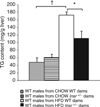Respective contributions of maternal insulin resistance and diet to metabolic and hypothalamic phenotypes of progeny
- PMID: 20948526
- PMCID: PMC3234171
- DOI: 10.1038/oby.2010.245
Respective contributions of maternal insulin resistance and diet to metabolic and hypothalamic phenotypes of progeny
Abstract
Maternal obesity can influence susceptibility to obesity and type 2 diabetes in progeny. We examined the relationship of maternal insulin resistance (IR), a metabolically important consequence of increased adiposity, to adverse consequences of obesity for fetal development. We used mice heterozygous for a null allele of the insulin receptor (Insr) to study the contributions of maternal IR to offspring phenotype without the potential confound of obesity per se, and how maternal consumption of high-fat diet (HFD) may, independently and interactively, affect progeny. In progeny fed a 60% HFD, body weight and adiposity were transiently (5-7 weeks) increased in wild-type (+/+) offspring of Insr(+/-) HFD-fed dams compared to offspring of wild-type HFD-fed dams. Offspring of HFD-fed wild-type dams had increased body weight, blood glucose, and plasma insulin concentrations compared to offspring of chow-fed wild-type dams. Quantification of proopiomelanocortin (POMC) and neuropeptide-Y (NPY) populations in the arcuate nucleus of the hypothalamus (ARH) of offspring of wild-type vs. Insr(+/-) dams was performed to determine whether maternal IR affects the formation of central feeding circuits. We found a 20% increase in the number of Pomc-expressing cells at postnatal day 9 in offspring of Insr(+/-) dams. In conclusion, maternal HFD consumption-distinct from overt obesity per se-was a major contributor to increased body weight, adiposity, IR, and liver triglyceride (TG) phenotypes in progeny. Maternal IR played a minor role in predisposing progeny to obesity and IR, though it acted synergistically with maternal HFD to exacerbate early obesity in progeny.
Conflict of interest statement
The authors declared no conflict of interest.
Figures







References
-
- Prevalence of overweight obesity and extreme obesity among adults: United States, trends 1960–62 through 2005–2006. National Center for Health Statistics, National Health and Nutrition Examination Survey. www.cdc.gov/nchs/data/hestat/overweight/overweight_adults.html.
-
- Ogden CL, Flegal KM, Carroll MD, Johnson CL. Prevalence and trends in overweight among US children and adolescents, 1999–2000. JAMA. 2002;288:1728–1732. - PubMed
-
- Ogden CL, Carroll MD, Curtin LR, et al. Prevalence of overweight and obesity in the United States, 1999–2004. JAMA. 2006;295:1549–1555. - PubMed
-
- Fowden AL, Hill DJ. Intra-uterine programming of the endocrine pancreas. Br Med Bull. 2001;60:123–142. - PubMed
Publication types
MeSH terms
Substances
Grants and funding
LinkOut - more resources
Full Text Sources
Medical
Miscellaneous

